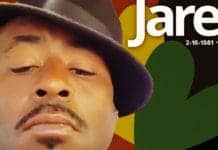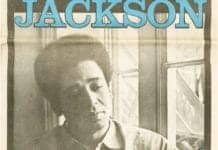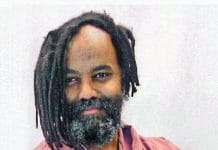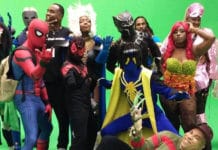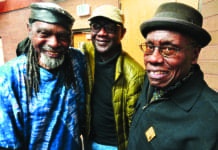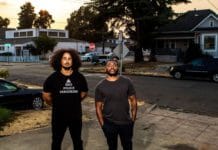
Review by Wanda Sabir
“Soul of a Nation: Art in the Age of Black Power” at the DeYoung museum is an opportunity for America to acknowledge the African presence at the heart of all that is human in this nation. Art articulates a vision; it is a language which negates artifice.
Black art specifically erases borders as it builds edifices which house spirit. It is the welcome home – home a new color, a new shape, a new landscape. Art is the language a people dispersed throughout the West speak to one another and in this exhibition organized by Mark Godfrey, Zoe Whitley and Tate Modern, at International Art in London, and remixed by curators Timothy Anglin Burgard and Lauren Palmor at the DeYoung in San Francisco, patrons walk slowly through a landscape that is as varied as a people speaking from these walls, display cases, pages in magazines and books.
The exhibit, which opened in November last year, closes with a community party on Saturday, March 14, with Boots Riley, who will be giving a free talk in the Koret Auditorium at 2 p.m. Tickets to “Soul of a Nation” are discounted to $10 on Saturdays, https://deyoung.famsf.org/education/free-saturdays.

What is remarkable about this exhibit is its currency and how the San Francisco Bay Area, while not completely eclipsed, is in a large part left out of the story narrated here. How is this possible? The San Francisco Bay Area with the Black Panther Party for Self-Defense reflected in so much visual design, from the music to Emory Douglas’s work as Minister of Culture for the BPP in the party newspaper … left out?
The Bay is so pivotal in the development of a social and political consciousness. This is one of the reasons why it is really important that you do not miss this iteration. When “Soul” opens in Houston next, the last stop on the tour, the stories that museum tells will be regionally specific and not include most of the art work curated for this stop.
When a body walks into “Soul of a Nation,” it cannot ignore the huge Romare Bearden work –a black and white collage. A founding member of the Spiral Movement, he is well known for his association with August Wilson’s century cycle – a work that looks at how over a period of 10 decades, Black Americans crafted their lives, a task that kept unraveling because the thread was caught in a system meant to harm.
You might notice the similarities between the two men. Wilson’s storytelling looks a lot like Bearden’s work – characters reappear, themes consistent. There is balance and then there is a life explored just enough off kilter to be interesting. Both men are also inspired by Black music of the period – jazz.

Born at the time of the Civil Rights Movements for racial justice, Mr. Richard Mayhew, retired professor, is another co-founder of Spiral. He said at a recent event that A. Phillip Randolph founded the group or at least gave the artists the idea to use their work to make a statement about the injustices Black people were experiencing.
What is unfortunate is Mr. Mayhew’s absence from the catalog and the traveling exhibition. How could such a pivotal pioneer be ignored? As “Soul” has toured the nation, Mr. Mayhew noticed his absence and told somebody: Sister Nashome Lindo, scholar and art collector, Mrs. Belva Davis, maverick journalist, Danny Glover perhaps and others, who collectively made sure Mr. Mayhew’s work – two black and white paintings, were included and that he was properly honored at the opening ceremonies which were full of pageantry and figurative fireworks. Mr. Mayhew, who gave many talks during the exhibition, gives background on Spiral in a wonderful audio tour created by the Fine Arts Museums and features Belva Davis and Danny Glover as moderators.
Lauren Palmor, co-curator, and I have a wonderful conversation on Wanda’s Picks Radio Show, Tuesday, March 10 (http://tobtr.com/s/11690803) about the social movements covered by the exhibition and perhaps why the Bay was omitted. Besides Mr. Mayhew, other artists with Bay Area connections are Ben Hazard, scholar, activist, artist who just made his transition in December. His piece “Medal of Honor” sits in a gallery that looks at the notion of heroism. When we think of “Blackness” as a concept, heroism certainly comes to mind whether that is as a soldier fighting for a country that does not value one’s humanity or, as Marie Johnson Calloway (1920-2018) shows with “Crossing Guard,” 1970s, African American women keep this nation’s children safe. Raymond Saunders’s (b. 1934) “Jack Johnson,” boxer, a Black man who knocked out a white man – yep – and lived.
Other artists with local ties are Elizabeth Catlett (1915-2012), whose Black Unity has the emblematic clenched fist carved from mahogany wood and then on the other side we see Black people. Together we are powerful. Many patrons do not know to walk around the work to see the opposite side. Betty Saar (b. 1926), “The Liberation of Aunt Jemima,” 1972, has the stereotypic troupe as an Nkisi. [Nkisi are spirits or an object, such as a carving, that a spirit inhabits. – ed.] Auntie has a rifle in one hand and a pistol in her lap.
There is much to commend the exhibition. I just noted works that might not travel given the regional flavor of some of the presentations.
Phillip Lindsay Mason (b. 1939), “Manchild in the Promised Land,” 1968, shows a little boy seated on a stoop, bullseye on his shirt. I thought about Claude Brown’s classic story of addiction, poverty and despair. Above the child’s shoulder we see a Pepsi logo. How does the commercial go? “Come Alive! You’re in the Pepsi Generation.” Interesting juxtaposition – the boy-child sits at the crossroads. Trayvon had Skittles and this child is associated with a beverage. Both are quarry. In the catalog, another painting by Mason is pictured: “The Deathmakers,” 1968. Acrylic paint on canvas 128.4 x 128.9. Whereabouts unknown.
In “Deathmakers,” two police as skeletons in their blue uniforms carry a Black man on a stretcher. An American flag is the backdrop for the picture, the stars below the dead man’s gurney, the stripes cover the sky, the canvas sphere shaped within a tight square (72). In the catalog, the work is juxtaposed with Archibald Motley’s “The First One Hundred Years: He Among You Who Is Without Sin Shall Cast the First Stone; Forgive Them Father For They Know Not What They Do,” 1963 (72).
The Motley work looks like something out of the Addams Family, but it’s no fictional scene here: Confederate flag is draped over a door with the Statue of Liberty standing next to a Black man hanging from a tree branch by a rope wrapped around his neck. Dr. King and Kennedy’s faces are hanging from the tree too like ornaments. Below there is a uniformed Klan member with a rope in his hand and a hungry hound licking his lips. Perhaps patrons will leave with a better understanding of the trauma associated in Black American minds, an often unconscious association, when they see dogs, dogs everywhere treated better than they. Given more rights to public space than they.

A fireman with a hose is walking away from a cross burning. Signs stating: “We want freedom now!” “Black Power!” “America for Whites! Africa for Blacks!” Behind him, there are no Black people, just an eerie fog or mist – more signage. “White Only,” “Colored Only” on opposite sides of the canvas, which is large. There is cotton, not clouds in the sky. Skulls and masks hang out in canvas corners. Perhaps this is what hell looks like.
I think this is the same room where Dana C. Chandler Jr.’s “Fred Hampton’s Door,” 1970, is also displayed. On the door where bullet holes are at center, there is a star and a label that says: “USA government approved ‘69” (71). A few pages before, Emory Douglas has an order form for Revolutionary Posters. Fred Hampton, the slain Chicago BPP leader, front page (62).
Make sure you have time to sit and watch the wonderful slide presentation with murals from Chicago’s Wall of Respect to Dewey Crumpler’s iconic mural on the side of the African American Art and Culture Complex, formerly Wajumbe Cultural Center on Fulton Street in San Francisco. Cleveland Bellow’s billboard is in the exhibition, one of 10 he painted and put in various locations in Oakland (1970). On the museum’s website, you can read more about the artist and what he called “social reality.” The boy’s hands are over his head and he looks to be smiling – today Black boys with hands raised are alarming. Funded by the Oakland Museum and the Foster & Kleiser billboard company, the uncluttered landscape allows multiple interpretations.
There is a screening room (just outside the final gallery near the gift shop) where patrons can view “Take This Hammer,” an hour-long film about James Baldwin’s 1963 visit to San Francisco to dramatize the city’s hypocrisy: oppressing Black people and pushing them out while boasting of its tolerance and progressive values. Only three years later, in 1966, Bayview Hunters Point exploded when police killed a 16-year-old and the city was placed under martial law by “liberal” Gov. Pat Brown. Watts had just gone up in smoke the previous year. Black resistance was in the air.
Bay View Arts Editor Wanda Sabir can be reached at wanda@wandaspicks.com. Visit her website at www.wandaspicks.com throughout the month for updates to Wanda’s Picks, her blog, photos and Wanda’s Picks Radio. Her shows are streamed live Wednesdays and Fridays at 8 a.m., can be heard by phone at 347-237-4610 and are archived at http://www.blogtalkradio.com/wandas-picks.

 Store
Store



